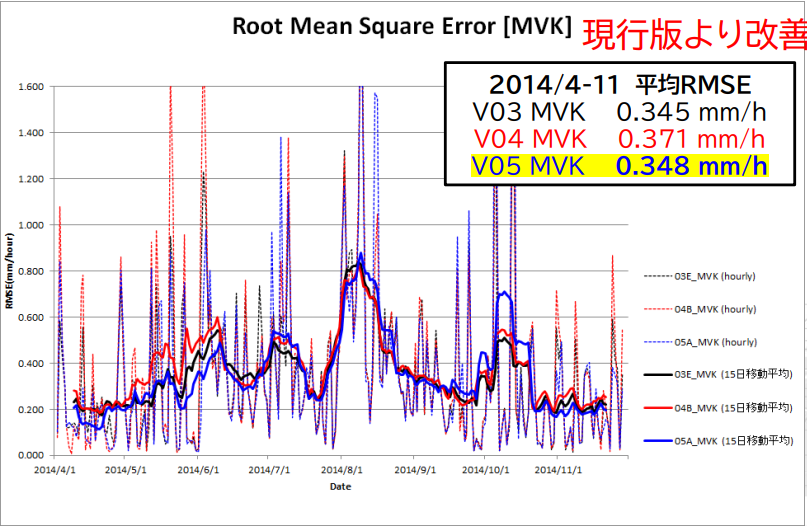Research of Precipitation Measuring Mission
JAXA Supercomputer System Annual Report February 2021-January 2022
Report Number: R21ER1400
Subject Category: Space Technology
- Responsible Representative: Riko Oki, Earth Observation Research Center
- Contact Information: Takuji Kubota(kubota.takuji@jaxa.jp)
- Members: Tomohiko Higashiuwatoko, Takeshi Masaki, Munehisa K. Yamamoto, Takuji Kubota, Tomoko Tashima, Moeka Yamaji, Kazuhiro Sakamoto
Abstract
Calculation of the global rainfall map derived from Tropical Rainfall Measuring Mission (TRMM) and the Global Precipitation Measurement (GPM) during a period from 2000 to 2014 using the GSMaP algorithm .
Checks of consistency between the TRMM Precipitation Radar (PR) algorithm and the GPM/DPR algorithm with long-term observation data.
Reference URL
Please refer to ‘GPM Website‘.
Reasons and benefits of using JAXA Supercomputer System
The JSS3 is necessary for calculation of the long-term data which consists of multiple satellites and sensors for the precipitation measurement with earlier computational times for algorithm evaluations, improvements, and long-term production. Because of the complexity of the processing algorithms, strict business progress management, emergency response, detailed user response by the operation side, etc. are required. When we do not use the JSS3, it can be said that reprocessing in a short period cannot be achieved.
Achievements of the Year
Several long-term test processes were conducted to develop algorithms for the GPM DPR V07 and GSMaP V05 major version update released in December 2021.
The results of the long-term statistical evaluation of precipitation showed that the GPM DPR was reasonable with no significant deviation from the existing product V06A, and that the GPM KuPR and TRMM PR, which are precipitation radars in Ku band, showed good continuity agreement (Fig.1). As for the GSMaP, the results of the comparison confirmed that the RMSE is improved over the existing product V04 (Fig.2). In the evaluation of these analyses, the time required for long-term test processing was significantly reduced by conducting them in JSS3, leading to an accelerated development cycle and the release of a major version of those products.

Fig.1: A trend of the precipitation of TRMM PR and GPM DPR at surface. Monthly unconditional mean in tropical region (35N-35S). Black line: TRMM PR (V07), Gray line:TRMM PR (V06A), Red line: GPM KuPR single frequency product (V07), Orange line: GPM KuPR single frequency product (V06A)

Fig.2: RMSE of GSMaP MVK. Black line: 03E, Red line: 04B, Blue line: 05A. Dashed line: hourly mean, Solid line: 15 days running mean.
Publications
– Peer-reviewed papers
H. Hirose, T. Kubota, T. Tashima, T. Mega, and T. Ushio, 2021: Histogram Matching to Improve Homogeneity in Satellite Merged Precipitation Products, IEEE GRSL, accepted.
J. Awaka, M. Le, S. Brodzik, T. Kubota, T. Masaki, V. Chandrasekar and T. Iguchi, 2021: Development of precipitation type classification algorithms for a full scan mode of GPM Dual-Frequency Precipitation Radar, J. Meteor. Soc. Japan, https://doi.org/10.2151/jmsj.2021-061
T. Masaki, T. Iguchi, K. Kanemaru, K. Furukawa, N. Yoshida , T. Kubota, and R. Oki, 2021: Calibration of the Dual-frequency Precipitation Radar (DPR) Onboard the Global Precipitation Measurement (GPM) Core Observatory, IEEE Trans. Geosci. Remote Sens., https://doi.org/10.1109/TGRS.2020.3039978.
M. Yamaji, T. Kubota, and M. K, Yamamoto, 2021: An Approach to Reliability Characterization of GSMaP Near-Real-Time Precipitation Product, J. Meteor. Soc. Japan, https://doi.org/10.2151/jmsj.2021-033.
S. Seto, T. Iguchi, R. Meneghini, J. Awaka,T. Kubota, T. Masaki and N. Takahashi, 2021: The Precipitation Rate Retrieval Algoirthms for the GPM Dual-frequency Precipitation Radar, J. Meteor. Soc. Japan, https://doi.org/10.2151/jmsj.2021-011.
– Invited Presentations
Recent Progresses of the Global Precipitation Measurement (GPM) Mission in Japan, Takuji Kubota, ICSANE2021、November 2021.
– Oral Presentations
Recent Progresses of the Global Precipitation Measurement (GPM) Mission in Japan
T. Kubota, M. Yamaji, T. Tashima, K. Yamamoto, R. Oki, Nobuhiro TAKAHASHI and Yukari N. Takayabu, EGU2021, April 2021.
– Poster Presentations
Evolution of Global Satellite Mapping of Precipitation (GSMaP) Product version 05, T. Kubota, K. Aonashi, T. Ushio, S. Shige, T. Tashima, M. K. Yamamoto, M. Yamaji, H. Hirose, T. Mega, A. Hamada, Yukari Takayabu, JpGU2021, May 2021.
– Web
JAXA Global Rainfall watch
https://sharaku.eorc.jaxa.jp/GSMaP/index.htm
GPM EORC
https://www.eorc.jaxa.jp/GPM/en/index.html
– Other
JMSJ Award 2021 (Seto, S., T. Iguchi, R. Meneghini, J. Awaka, T. Kubota, T. Masaki, and N. Takahashi, 2021: The Precipitation rate retrieval algorithms for the GPM Dual-frequency Precipitation Radar. J. Meteor. Soc. Japan, 99, 205-237.)
Usage of JSS
Computational Information
- Process Parallelization Methods: N/A
- Thread Parallelization Methods: N/A
- Number of Processes: 1
- Elapsed Time per Case: 24 Hour(s)
JSS3 Resources Used
Fraction of Usage in Total Resources*1(%): 0.09
Details
Please refer to System Configuration of JSS3 for the system configuration and major specifications of JSS3.
| System Name | CPU Resources Used(Core x Hours) | Fraction of Usage*2(%) |
|---|---|---|
| TOKI-SORA | 0.00 | 0.00 |
| TOKI-ST | 640830.25 | 0.79 |
| TOKI-GP | 0.00 | 0.00 |
| TOKI-XM | 0.00 | 0.00 |
| TOKI-LM | 0.00 | 0.00 |
| TOKI-TST | 144.43 | 0.00 |
| TOKI-TGP | 0.00 | 0.00 |
| TOKI-TLM | 0.00 | 0.00 |
| File System Name | Storage Assigned(GiB) | Fraction of Usage*2(%) |
|---|---|---|
| /home | 58.33 | 0.06 |
| /data and /data2 | 97363.33 | 1.04 |
| /ssd | 183.33 | 0.05 |
| Archiver Name | Storage Used(TiB) | Fraction of Usage*2(%) |
|---|---|---|
| J-SPACE | 71.08 | 0.48 |
*1: Fraction of Usage in Total Resources: Weighted average of three resource types (Computing, File System, and Archiver).
*2: Fraction of Usage:Percentage of usage relative to each resource used in one year.
ISV Software Licenses Used
| ISV Software Licenses Used(Hours) | Fraction of Usage*2(%) | |
|---|---|---|
| ISV Software Licenses(Total) | 0.00 | 0.00 |
*2: Fraction of Usage:Percentage of usage relative to each resource used in one year.
JAXA Supercomputer System Annual Report February 2021-January 2022


